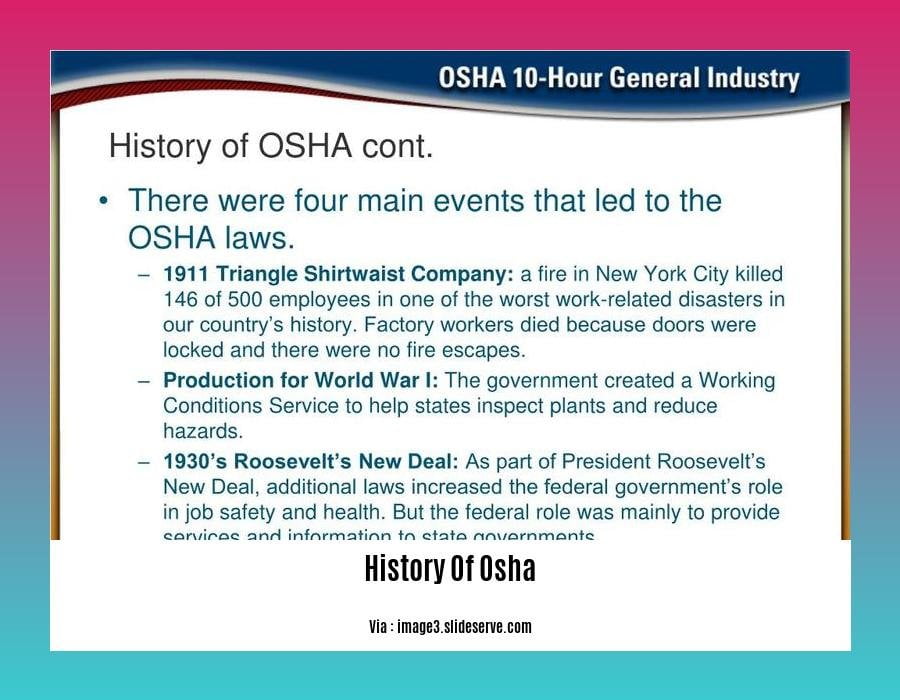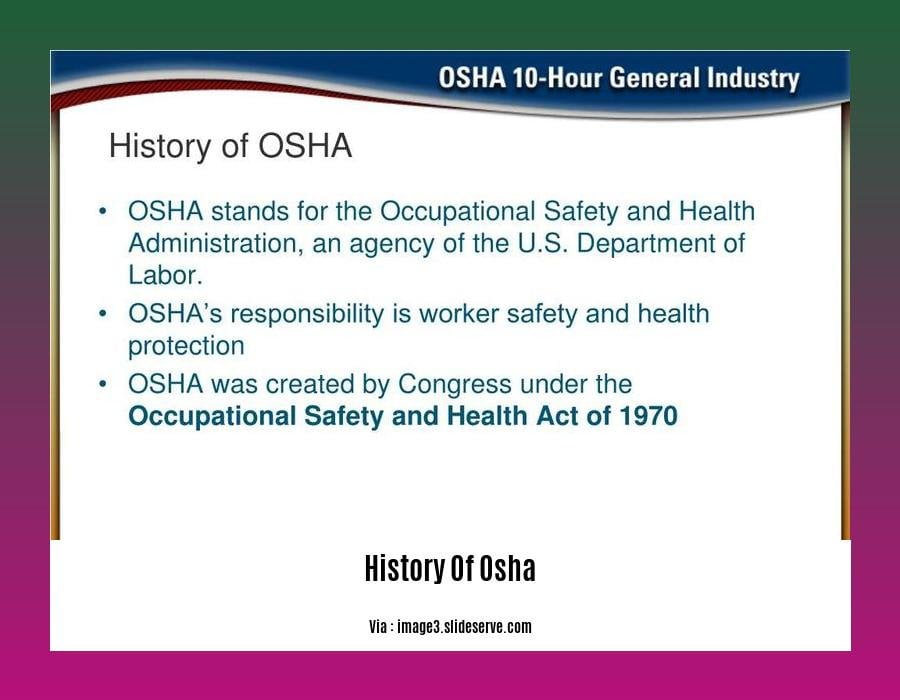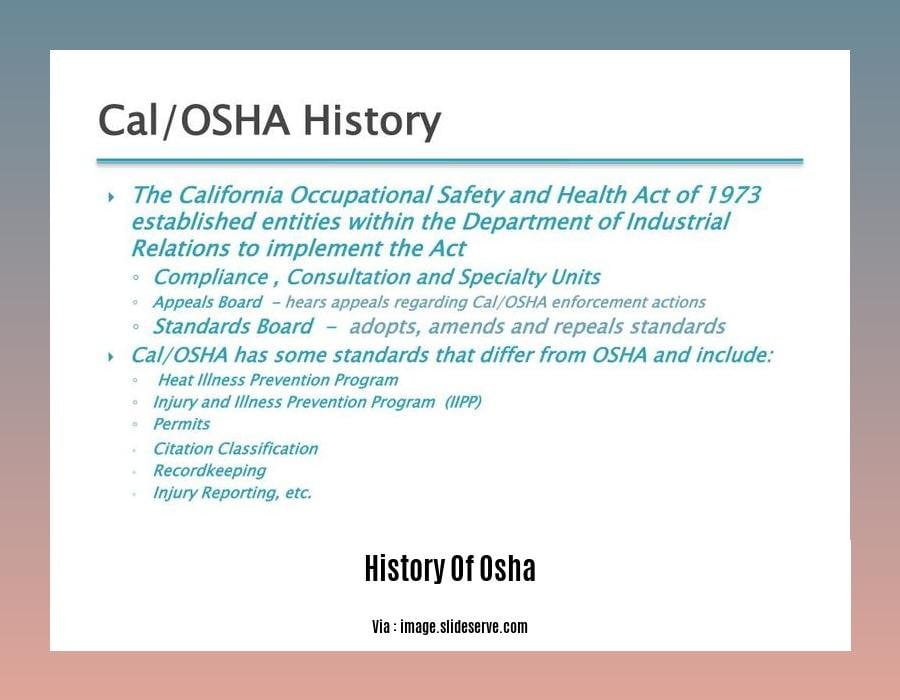Embark on a captivating journey through the annals of workplace safety as we unveil the history of OSHA. From its humble beginnings to its profound impact on modern-day labor standards, discover the evolution of the Occupational Safety and Health Administration (OSHA) and its unwavering commitment to safeguarding the well-being of workers across America.
Key Takeaways:
OSHA was established in 1971 to address the high number of workplace fatalities and potential hazards.
It sets and enforces safety standards, provides training and assistance, and promotes education to ensure safe and healthy working conditions.
OSHA’s creation marked a significant turning point in workplace safety regulations.
Subheading: A Walk Through Time: The History of OSHA

From a grim reality to a movement for safety
Workplace safety regulations weren’t always a priority until the industrial revolution. The harsh conditions and the rise in injuries and fatalities in industries such as manufacturing and mining called for urgent action. In the United States, the establishment of the Occupational Safety and Health Administration (OSHA) in 1971 marked a turning point in workplace safety.
The Driving Force Behind OSHA
The creation of OSHA was a direct response to the alarming statistics of workplace fatalities and injuries. The Occupational Safety and Health Act of 1970, the foundation of OSHA, aimed to ensure safe and healthy working conditions for every American worker.
OSHA’s Enduring Impact
Since its inception, OSHA has played a crucial role in improving workplace safety. Its comprehensive standards, training programs, and enforcement actions have contributed to a significant reduction in workplace hazards and injuries. OSHA’s impact extends beyond regulations; it has fostered a culture of safety consciousness and risk prevention in workplaces across the nation.
A Collaborative Effort Towards Safety
OSHA’s success story isn’t just its own; it’s a testament to the collective efforts of various stakeholders. Unions, industry groups, safety professionals, and workers have all contributed to OSHA’s effectiveness. Their active participation in standard-setting, training, and compliance has been instrumental in creating safer workplaces.
Addressing Dynamic Challenges
OSHA’s journey has been marked by continuous adaptation to evolving workplace hazards and challenges. From addressing new technologies and industries to responding to emerging risks like pandemics, OSHA has demonstrated its commitment to staying ahead of the curve.
The Road Ahead: Safety Without Compromise
As we look to the future, OSHA continues to face new frontiers in workplace safety. The rise of automation, artificial intelligence, and the changing nature of work demand innovative approaches to safety. OSHA’s commitment to research, collaboration, and enforcement will be essential in navigating these uncharted territories.
In conclusion, the history of OSHA is a testament to the power of collective action in creating safer workplaces. Through its unwavering dedication to protecting workers, OSHA has transformed the landscape of workplace safety, saving countless lives and preventing countless injuries. Its legacy of safety and health will continue to shape the future of work, ensuring that every worker has the right to a safe and healthy work environment.
Find yourself perplexed about the history of the Nathdwara temple? Click on this link to delve into the rich tapestry of this sacred shrine’s past: history of Nathdwara temple.
Have you ever pondered the captivating history of occupational therapy? Embark on a journey through time and discover the fascinating evolution of this noble profession: history of occupational therapist.
The Kennedy administration championed worker safety, and in 1970, President Nixon signed the Occupational Safety and Health Act.

Workplace safety took a momentous leap forward when President Lyndon B. Johnson championed the cause in 1968, seeking to establish comprehensive safety measures for American workers. Although his efforts didn’t bear immediate fruit, the stage was set for a transformative change. Two years later, President Richard Nixon signed the groundbreaking Williams-Steiger Occupational Safety and Health Act, also known as OSHA, into law on December 29, 1970. This landmark legislation empowered the federal government to set and enforce stringent safety and health standards, ensuring the well-being of millions of American workers.
A Catalyst for Change: The Driving Forces Behind OSHA
The creation of OSHA wasn’t a mere coincidence; it was a direct response to the alarming statistics of workplace fatalities and injuries that plagued the nation during the industrial revolution. The sheer number of avoidable accidents and the devastating impact they had on workers and their families demanded immediate action. OSHA emerged as a beacon of hope, aiming to prevent work-related injuries, illnesses, and fatalities, thus creating a work environment that prioritized the well-being of every American worker.
OSHA’s Cornerstones: A Multifaceted Approach to Workplace Safety
OSHA’s mission is multifaceted, encompassing a range of strategies to ensure safe and healthy working conditions. At its core, OSHA establishes comprehensive standards that set clear expectations for workplace safety. These standards cover various aspects, including exposure limits to hazardous substances, machine guarding, personal protective equipment, and emergency procedures. To ensure compliance, OSHA conducts thorough inspections, investigating potential violations and taking appropriate enforcement actions when necessary. Additionally, OSHA provides valuable training and education programs, empowering workers and employers with the knowledge and skills to identify and mitigate workplace hazards.
The Road Ahead: OSHA’s Unwavering Commitment to Safety
OSHA’s journey doesn’t end here. The organization remains committed to continuously adapting to evolving workplace hazards. As technology advances, new industries emerge, and unforeseen risks like pandemics arise, OSHA stands ready to address these challenges head-on. Through ongoing research, collaboration with stakeholders, and unwavering enforcement efforts, OSHA strives to create a future where every American worker can perform their duties in a safe and healthy environment.
Key Takeaways:
In 1968, President Lyndon B. Johnson championed worker safety, advocating for comprehensive safety measures.
The Williams-Steiger Occupational Safety and Health Act, signed by President Richard Nixon in 1970, marked a turning point in workplace safety regulations.
OSHA’s mission is to prevent work-related injuries, illnesses, and deaths, ensuring a safe and healthy work environment for every American worker.
OSHA establishes comprehensive standards, conducts inspections, and provides training and education to promote workplace safety.
OSHA continuously adapts to evolving workplace hazards, addressing new technologies, industries, and emerging risks.
Citations:
[2] European Agency for Safety and Health at Work:
OSHA Faced Resistance from Industries Concerned About Costs and Regulations
While the enactment of OSHA ushered in a new era of workplace safety, it wasn’t without its challenges. The agency faced strong resistance from industries concerned about the associated costs and regulations. Many businesses argued that complying with OSHA requirements would lead to increased operational expenses, reduced efficiency, and a potential loss of competitiveness.
The Clash of Interests:
The tension between protecting worker safety and minimizing business costs created a complex dynamic. Industries expressed apprehension about the financial implications of implementing safety measures, such as purchasing protective equipment, conducting employee training, and redesigning work processes to meet OSHA standards. They feared that these expenses would eat into their profit margins and make it difficult to compete in the market.
A Balancing Act:
OSHA recognized the need to balance worker protection with business viability. The agency engaged in extensive consultations and negotiations with industry representatives, labor unions, and safety experts to find common ground. OSHA strived to craft regulations that were both effective in safeguarding employees and feasible for businesses to implement without causing undue financial strain.
Incremental Progress:
Despite the initial resistance, OSHA gradually gained acceptance and support from many industries. As businesses realized the long-term benefits of a safer workplace, such as reduced worker injuries, decreased absenteeism, and improved productivity, they became more willing to invest in compliance. OSHA’s collaborative approach and commitment to finding practical solutions helped to bridge the divide between worker safety and business concerns.
Key Takeaways:
OSHA’s mission to improve workplace safety faced initial pushback from industries worried about increased costs and regulatory burdens.
Industries expressed concerns that complying with OSHA standards would hurt their profitability and competitiveness.
OSHA sought to strike a balance between worker protection and business viability through consultations, negotiations, and the development of feasible regulations.
As industries recognized the long-term benefits of a safer workplace, they became more supportive of OSHA’s efforts.
OSHA’s commitment to collaboration and finding practical solutions helped to bridge the divide between worker safety and business interests.
Over the years, OSHA has adapted to changing workplace hazards and issued new standards to ensure worker safety.
We have all heard shocking tales of hazardous workplaces, where employees faced perilous conditions that endangered their health and safety. These stories often serve as a grim reminder of the importance of workplace safety regulations, and OSHA has played a pivotal role in shaping this landscape.
OSHA’s Evolving Role in Workplace Safety
When OSHA was established in 1970, it marked a turning point in the history of workplace safety in the United States. Prior to OSHA, there was no comprehensive federal agency responsible for overseeing and enforcing workplace safety standards. As a result, workplace injuries and fatalities were rampant, with workers facing unacceptable risks in various industries.
OSHA’s Impact
Since its inception, OSHA has made tremendous strides in improving workplace safety conditions. The agency has established and enforced safety standards, conducted inspections, and provided training and education to employers and employees. This comprehensive approach has led to a significant reduction in workplace injuries, illnesses, and fatalities.
Adapting to Changing Hazards
The world of work is constantly evolving, and OSHA has consistently adapted to meet the challenges posed by changing workplace hazards. In recent years, the agency has focused on addressing emerging risks such as nanotechnology, green jobs, and the increasing use of automation and robotics. By staying abreast of these changes, OSHA ensures that workers are protected from the latest safety threats.
Key Takeaways:
OSHA was established in 1970 to ensure safe and healthful working conditions for American workers.
Since its inception, OSHA has significantly reduced workplace injuries, illnesses, and fatalities through standards, inspections, training, and education.
OSHA continuously adapts to evolving workplace hazards, addressing new technologies, industries, and emerging risks.
FAQ
Q1: What prompted the establishment of OSHA?
A1: OSHA was established in 1971 in response to the alarming number of workplace fatalities and the high potential for workplace hazards to cause severe or fatal injuries.
Q2: What were the key legislative measures that led to the creation of OSHA?
A2: The Williams-Steiger Occupational Safety and Health Act, signed into law by President Richard Nixon in 1970, gave the federal government the authority to set and enforce safety and health standards for most U.S. workers.
Q3: What are OSHA’s primary goals and objectives?
A3: OSHA’s main goal is to prevent work-related injuries, illnesses, and deaths by setting and enforcing standards, providing training, conducting outreach and education programs, and offering assistance to employers and employees to ensure safe and healthful working conditions.
Q4: How has OSHA impacted workplace safety in the United States?
A4: OSHA has significantly reduced the number of workplace fatalities and injuries since its establishment, contributing to a 40% decrease in the U.S. occupational injury rate compared to when the agency was formed.
Q5: What are some of the challenges that OSHA has faced throughout its history?
A5: OSHA has faced challenges such as limited resources, controversies surrounding its regulations, and the need to balance worker safety with other considerations, such as economic feasibility and employer rights.
- Crypto Quotes’ Red Flags: Avoid Costly Mistakes - June 30, 2025
- Unlock Inspirational Crypto Quotes: Future Predictions - June 30, 2025
- Famous Bitcoin Quotes: A Deep Dive into Crypto’s History - June 30, 2025





![[History of EMS Timeline]: A Journey from Humble Beginnings to Sophisticated Healthcare history-of-ems-timeline_2](https://www.lolaapp.com/wp-content/uploads/2023/12/history-of-ems-timeline_2-150x150.jpg)










